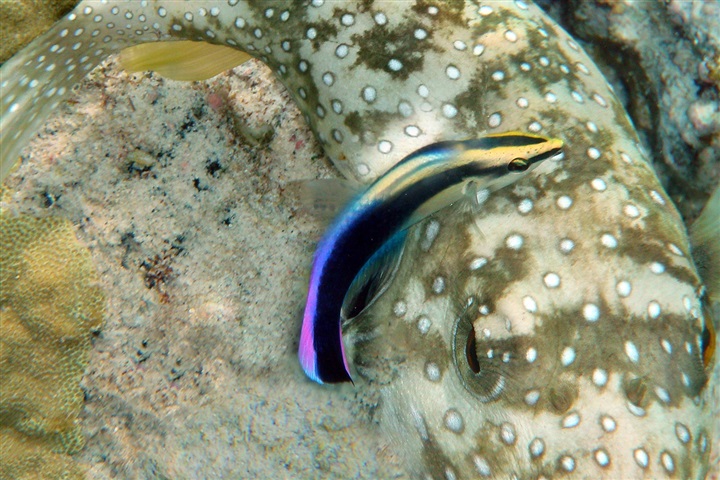Labroides phthirophagus

| Latin name | Labroides phthirophagus - Randall, 1958 |
|---|---|
| Local name | Hawaiian cleaner wrasse |
| Family | Labridae - Labroides |
| Origin | East Pacific |
| Max length | 12 cm (4.7") |
| Minimum volume |
1000 l (264 gal) |
|---|---|
| Hardiness |
Average |
| Suitable for aquarium |
Experience, preparation and extra care required |
| Reef safe |
Always reef safe |
| Aggressiveness | Mostly peaceful but might be aggressive towards similar species of same gender |
| Recommended |
Parasites |
|---|---|
| Maybee |
Small crustaceans (Krill, mysis, artemia...) Zooplankton (Cyclops, pods...) |
This species can be fastidious and in an aquarium it can be very difficult to get them to eat sufficiently.
It is recommended that this species be kept by experienced aquarists as it requires specialized food for its continual survival.
This fish requires feeding several times a day, especially when newly added.
When the fish can find its natural food in the aquarium it requires less frequent feeding.
They can live as a pair provided they are introduced simultaneously.
This species can change gender from female to male.
When a male is needed, a female changes sex and takes on the role.
This species is able to remove parasites from fish.
It does not have a great impact on a large outbreak of marine ich (Cryptocaryon), for example, but it contributes towards keeping fish parasite free.
Constant cleaning can stress the fish in the aquarium, so one should not add this fish which removes parasites, if the fish are already weakened through other causes.
Not all specimens actively clean fish.
Cleaner Wrasses, of the labroides genus, remove parasites from fish, but only particular types of parasites.
They do not remove marine ich (Labroides dimidiatus are the easiest to keep in an aquarium as they will often happily eat frozen food, especially if helped along by having live food to begin with.
These fish can be kept in pairs or alone, but two males will kill each other.
As it can be problematic to distinguish gender, one should buy these fish at a young age, if one wishes to have a pair.
They sleep in a mucous cocoon between the rocks.
Even though predatory fish will rarely eat Cleaner Wrasses in the wild, the same cannot be said for in captivity.
Wrasses are nearly always seen in reef aquaria, since many of the species are both attractive and useful in battling a range of unwanted invertebrates like i.e. flatworms, pyramide snails.
These fish live of everything from zooplankton to large crustaceans, sea urchins and the like.
The needs and behaviour of Wrasses vary greatly, so it is vital to familiarize oneself with the specific species before buying one.
| Aquarium trade | Yes |
|---|---|
| Distribution | Eastern Central Pacific: Hawaiian Islands (Ref. 583) and Johnston Islands (Ref. 28618). |
| English common names |
Hawaiian cleaner wrasse |
| Danish common names |
Hawaii-pudsefisk |
Bob Fenner. Cleaner Wrasses in the Genus Labroides - Wet Web Media - (English)
Scott W. Michael. 2009. Wrasses and Parrotfishes (Reef Fishes Series Book 5) - TFH Publications / Microcosm Ltd. - (English)

